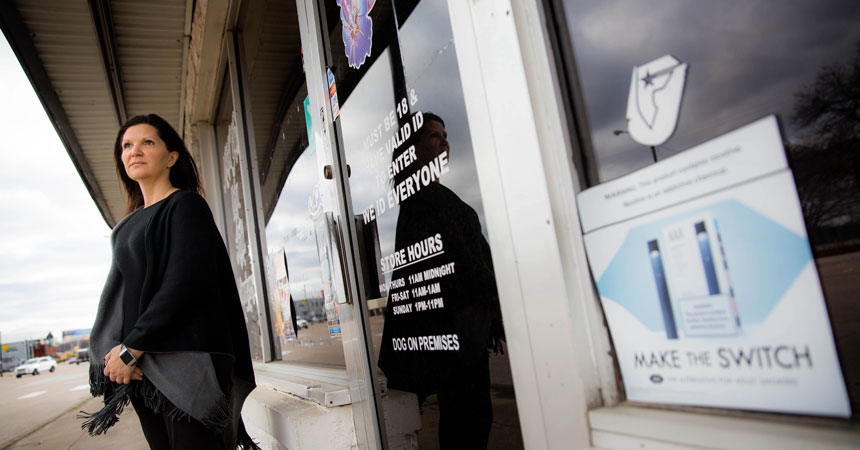Clearing the air about vaping
A Fort Worth mother of two discovered some unusual items while unpacking her family’s suitcases on vacation.
Turns out, she had found her 15-year-old son’s JUUL pods. He had been secretly vaping, joining the tens of thousands of kids across the U.S. who have fallen prey to the latest hot – and dangerous – trend among adolescents and young adults.
In recent years, more and more high school and college students, even middle schoolers, have been trying this form of electronic cigarettes, cleverly marketed to youth by tobacco and e-cig companies eager to attract a new generation of consumers.
“Vaping has become the newest cool thing to do,” said Dr. Tracey Barnett, Associate Dean for Academic Affairs at the UNT Health Science Center School of Public Health. “The problem is, many people aren’t fully understanding the potential long-term effects and addictive qualities of these products, or how widespread the problem really is.”
Data from the Office of the Surgeon General and a 2016 National Youth Tobacco Survey reported a 900 percent increase in e-cigarette use by U.S. high school students during the years 2011-2015, with 1.7 million high school students and around 500,000 middle school students saying they had used e-cigarettes in the previous 30 days.
The industry is huge and growing. E-cigarette advertising expenditures have increased dramatically in recent years, from $12 million in 2011 to $125 million in 2014, and it is estimated that more than 460 e-cig brands are currently on the market, with more than 7,700 vapor flavors to choose from.
“With flavorings packaged like juice boxes and candy, and youth-oriented, fun names like gummy bear, cosmic cranberry and very berry blue, it’s clear who is being targeted,” Dr. Barnett said. “Many of these products are loaded with nicotine and contain other chemicals that may be dangerous.”
Dr. Barnett’s research is focused on the health risks of nicotine, tobacco-related products and now the youth vaping epidemic.
Like others in public health, medicine, the research field, education and consumer safety, she has serious concerns and is working to address this problem.
Dr. Barnett has published articles on the topic and is active with parent groups, educators, school staff and counselors, community organizations, legislators, the media and especially students, to share the facts about e-cigarette use.
How does it work?
“Electronic nicotine delivery systems go by different names,” Dr. Barnett said. “E-cigs, vapes, vape pens, e-pens, mods, e-hookahs and tanks are all common terms, and most recently, new names have popped up around specific brands like JUUL, which looks deceptively like a USB device or flash drive.”
Vaping problem among the youngThe scope The danger The solution |
E-cigarettes have been marketed as a safer alternative to smoking, a way to reduce smoking and a tool to help users quit, although this has not been backed by the FDA.
Rather than burning tobacco and producing smoke or odor, they release a vapor. The steam inhaled is made up of nicotine and liquid chemicals, which can include added scents and flavor juices.
Early research has found that some of these smokeless tobacco products contain three to four times more nicotine than cigarettes. But because this trend is still relatively new to the United States, the industry remains largely unregulated, and little is yet known about the long-term health effects, Dr. Barnett said.
Vaping is widely marketed through social media, gaming sites and youth-oriented radio. The products can be purchased online or through vape shops.
“Users must be over 18, but we all know there are ways around that,” Dr. Barnett said.
Parents like the Fort Worth mother, who chooses to remain anonymous, often are caught unaware, with little knowledge of how their kids are getting the products.
“My husband and I were shocked to find out that our son had been vaping for three or four months or maybe even longer,” she said. “We learned that the football field at his school was pretty much a lunchtime marketplace for obtaining JUULs. Older students were ordering the products online and selling them to younger kids.”
Her family alerted their high school principal, and they have been monitoring their son in new ways since.
“Trust has become a big issue. We changed to a non-cash system for his spending money,” she said. “There were times when we wouldn’t let my son close the door to his room, and I still check the nightstand drawers by his bed. But how can parents really fix the problem when practically anything can be found on the internet and there are vape shops on just about every corner?”
Not all vape shops check IDs for age, and many internet sites only require a “yes, I’m over 18” click for access.
“Sometimes it’s as simple as knowing a friend of a friend, or someone’s older relative who doesn’t mind making the purchase,” said a local high school administrator. “It’s like the old story of a buddy who buys you beer. Kids are resourceful in getting what they want.”
Growing concerns
According to the Consumer Advocates for Smoke Free Alternatives Association, electronic cigarettes are not new.
A pharmacist, inventor and smoker in China created the first commercially successful e-cigarette in 2003. He reportedly was inspired by the loss of his father, a heavy smoker who died of lung cancer.
By 2007, electronic cigarettes had been introduced in Europe and the United States.
As e-cigarette use has increased, researchers, the medical and public health industries, and agencies like the CDC and World Health Organization have rejected the products as a safe alternative to smoking, warning the toxic chemicals may cause more health problems than the nicotine in regular cigarettes.
In December 2018, the U.S. Surgeon General called the problem a serious epidemic among youth and stressed the importance of “protecting children from a lifetime of nicotine addiction and associated health risks.”
“Here’s what we know. Nicotine is addictive,” Dr. Barnett said. “Nicotine can harm the developing brain, especially during adolescence. Teenagers are much more susceptible to addiction, and withdrawal can bring on anxiety, irritability, depression, physical symptoms and loss of concentration.”
“Some vapes being marketed as having zero percent of nicotine have actually been found to contain nicotine,” she said. “But that’s not all. Particles of other dangerous substances have also been detected, such as metals like nickel, cadmium and lead, and carcinogens like formaldehyde.”
Even the seemingly harmless flavor additives are suspect.
“Very little is known yet about the long-term effects of inhaling flavor ingredients. While they might be approved for ingestion, that doesn’t necessarily mean they are safe to take into the lungs,” Dr. Barnett said.
Getting hurt, getting high
E-cigarette explosions are another increasing cause for concern, a fact emphasized locally last February when a man was killed after a device exploded in his face outside a Keller vape shop.
In a recent Tobacco Control article published by UNTHSC-SPH alumnus Dr. Matthew Rossheim, SPH Dean Dr. Dennis Thombs and colleagues, an estimated 2,035 e-cigarette explosions and burn injuries, close to three per day, were reported by hospital emergency departments between 2015 and 2017.
“There is potential for the batteries in these devices to overheat, ignite or explode,” Dr. Thombs said. “Although previously considered as rare occurrences, our research found there were actually more incidents in the U.S. than estimated in the past. More research is needed into the risk of serious and even deadly injuries and burns.”
Drugs can present dangers of another kind that students and parents should be aware of, said Kathryn Everest, Director of Counseling Services for the Fort Worth Independent School District.
“Marijuana users have found ways to mask the smell by mixing flavor juices with liquid marijuana compound, so they can smoke pot virtually undetected,” she said. “There have also been situations where other drugs were used to lace these products and kids have ended up in the emergency room. Students need to understand how serious this is, and that though it might seem harmless to share a puff from a vape pen at a party, there’s no telling what is in the pen.”
Honest conversations
Parents with questions can consult their school, their health provider or reliable online resources like the Truth Initiative, the country’s largest non-profit public health organization dedicated to tobacco education.
“Conversations around the dinner table are so important to talk openly about vaping, just like drugs and other situations that teens and young adults may face,” said Coby Bird, Principal at Southwest Christian School in Benbrook, whose high school is battling the problem through campus awareness programs, parent education and student counseling.
More conversation is also needed, Dr. Barnett said, regarding how the products are marketed and sold. New legislation has been proposed in Texas to raise the legal age for buying tobacco products, including e-cigarettes, to 21.
“When the FDA recently ordered JUUL producers to stop selling their flavored products seemingly intended for children, the company complied by no longer sending them to stores, but it didn’t stop production,” she said. “They can still be purchased online.”
“E-cigarettes are threatening to negate all of the progress made to reduce the damages and health risks from smoking in the U.S.,” Dr. Barnett said. “Future actions on this problem will be important to the safety of our children and generations to come.”




![Uyen Sa Nguyen Scaled[58]](https://www.unthsc.edu/newsroom/wp-content/uploads/sites/16/Uyen-Sa-Nguyen-scaled58-145x175.jpg)



Social media